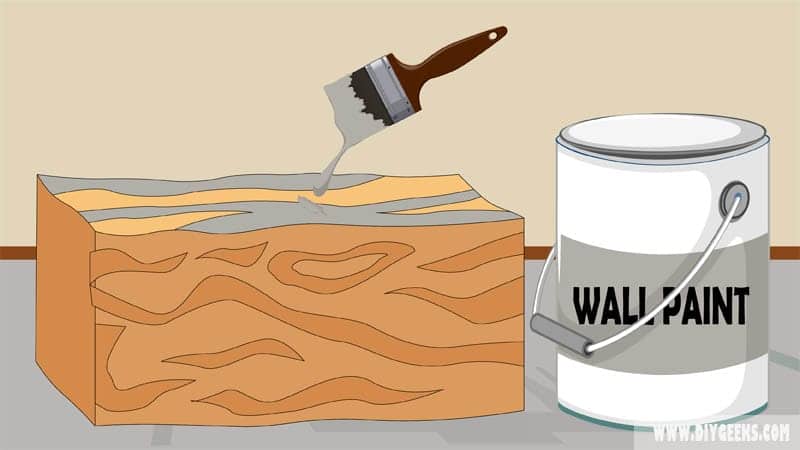You can paint furniture with wall paint, but you must apply a primer coating to improve the paint adhesion and seal the finish to improve its durability.
To paint furniture with wall paint, sand the furniture surface, apply primer, apply wall paint, and seal the finish.
The benefits of using wall paint over furniture include easier to clean and maintain finish, while the drawbacks include weak paint adhesion and low finish durability.
What Are the Benefits of Painting Furniture With Wall Paint?
The benefits of painting furniture with wall paint include easier to clean and maintain, a stain-resistant finish, and a brighter finish.
Wall paint is easier to clean and maintain as its finish is resistant to water, so you can use liquid-based cleaner to clean it. Wall paint creates a stain-resistant finish that can protect furniture from stains and other small damages.
The finish color shade will be brighter as wall paint is designed to produce a bright finish compared to other paints.
What Are the Drawbacks of Painting Furniture With Wall Paint?
The drawbacks of painting furniture with wall paint include weak paint adhesion, cracked or chipped finish, low finish durability, and raised wood grain.
Since wall paint is designed for wall surfaces, the paint has a thicker viscosity and won’t adhere well to furniture surfaces as it can’t properly penetrate the surface pores. This leads to a weak paint adhesion that produces a cracked or chipped finish.
To improve the adhesion between the wall paint and the furniture surface, apply a primer coating.
If you apply wall paint on furniture, the paint finish will have low durability and won’t last long. That’s because wall paint isn’t resistant to constant touching or handling and the paint can peel off. You must apply a wood sealer over the paint to increase its durability.
Some wall paints can discolor and create brown patches over the furniture surface because they have rust-prevention additives that leave iron deposits on the surface.
How To Paint Furniture With Wall Paint?
To paint furniture with wall paint, do the following things.
- Sand the Furniture Surface.
- Apply Primer.
- Apply Wall Paint.
- Seal the Finish.
The tools you need for this project are listed below.
- Sandpaper
- Wall paint
- Angled paintbrushes
- Spray gun
- Paper type and sheets
- Polyurethane
- Primer (preferably oil-based)
- Wood filler
- Safety Gears
1. Sand the Furniture Surface
Sand the furniture surface with fine-grit sandpaper (220-grit) to remove imperfections and bumps, and create a rough texture that improves paint penetration and adhesion.
If the furniture surface is riddled with too many imperfections, bumps, or stubborn stains, use medium-grit sandpaper (100-grit).
If the furniture is cracked or damaged, use wood filler to fill and repair the dents before applying the paint. Simply apply the wood filler over the dents or cracks, remove the excess, wait around 30 minutes, and sand the affected areas with fine-grit sandpaper (220-grit).
Ensure to clean and remove dust after sanding.
2. Apply Primer
Apply one (1) primer coat over the furniture surface. The primer creates a textured layer over the surface and enhances paint penetration and adhesion.
3. Apply Wall Paint
Apply 2-3 thin wall paint coats over the furniture surface. Wait until one coat dries before applying the next one.
It’s recommended to use a paint sprayer as it applies thinner paint coats and sprays it faster.
4. Seal the Finish
Seal the wall paint finish with a wood sealer to protect it from moisture, water, or scratches. Wall paint isn’t designed to withstand constant usage, touching, or handling, and can peel off if you don’t seal it.
Furniture Paint vs. Wall Paint
The paint formula is the main difference between furniture and wall paint. Wall paint contains synthetic resins and additives to improve its adhesion to wall, concrete, or stone surfaces. Furniture paint contains binders and additives that help it penetrate and adhere to wooden surfaces.
Wall paint is designed to adhere to vertical surfaces, while furniture paint is designed to penetrate and adhere over wooden surfaces.
Wall paint contains a higher pigment amount as they are designed to create a colorful or bright finish over wall surfaces. For instance, acrylic wall paint is used for murals or wall art and contains a high pigment amount.
Furniture paint contains more protective additives as the paint is designed to be resistant to constant handling or touching.
Can You Use Furniture Paint on Walls?
You can’t use furniture paint on wall surfaces as the paint doesn’t adhere properly to vertical surfaces. The paint does initially adhere, but it will gradually peel off.
Furniture paint doesn’t have synthetic resins that improve its adhesion to walls, concrete, brick, or vertical surfaces. The paint will drip off the wall surface as it’s not designed to penetrate and adhere over vertical surfaces.
You can apply a primer coating over the wall surface to improve the paint adhesion, but even that can’t guarantee a good or durable finish.
Pro Tip: Though you can alternate wall and furniture paint in their uses, it’s best not to do so until it’s a last resort if you want to avoid wastage. It’s better to use a type designed for the surface you are working on for better results.


